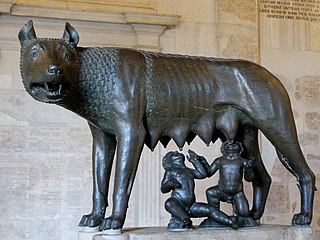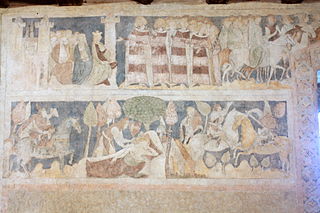 W
WThe Book of Abramelin tells the story of an Egyptian mage named Abraham, or Abra-Melin, who taught a system of magic to Abraham of Worms, a Jew in Worms, Germany, presumed to have lived from c.1362–c.1458. The system of magic from this book regained popularity in the 19th and 20th centuries partly due to Samuel Liddell MacGregor Mathers' translation, The Book of the Sacred Magic of Abramelin the Mage; and partly to its importance within the Hermetic Order of the Golden Dawn, and later within the mystical system of Thelema.
 W
WThe Capitoline Wolf is a bronze sculpture depicting a scene from the legend of the founding of Rome. The sculpture shows a she-wolf suckling the mythical twin founders of Rome, Romulus and Remus. According to the legend, when King Numitor, grandfather of the twins, was overthrown by his brother Amulius in Alba Longa, the usurper ordered them to be cast into the Tiber River. They were rescued by a she-wolf that cared for them until a herdsman, Faustulus, found and raised them.
 W
W"Dies irae" is a Latin sequence attributed to either Thomas of Celano of the Franciscans (1200–1265) or to Latino Malabranca Orsini, lector at the Dominican studium at Santa Sabina, the forerunner of the Pontifical University of Saint Thomas Aquinas in Rome. The sequence dates from the 13th century at the latest, though it is possible that it is much older, with some sources ascribing its origin to St. Gregory the Great, Bernard of Clairvaux (1090–1153), or Bonaventure (1221–1274).
 W
WEpítome de la conquista del Nuevo Reino de Granada is a document of uncertain authorship, possibly (partly) written by Spanish conquistador Gonzalo Jiménez de Quesada between 1548 and 1559. The book was not published until 1889 by anthropologist Marcos Jiménez de la Espada in his work Juan de Castellanos y su Historia del Nuevo Reino de Granada.
 W
WFaazin Gei, or The Flowery Paper is a Chinese mukjyusyu style ballad written in the late Ming era. It is the earliest known work containing elements of written Cantonese. This book was also of particular interest to early European Sinology. Along with Iu-Kiao-Li, it is regarded the most influential Chinese book for 19th century European writers.
 W
WThe Gospel according to John is the fourth of the four canonical gospels. It contains a highly schematic account of the ministry of Jesus, with seven "signs" culminating in the raising of Lazarus and seven "I am" discourses culminating in Thomas' proclamation of the risen Jesus as "my Lord and my God". John's account contains Jesus' Farewell Discourse, in which he speaks plainly to his apostles before his crucifixion. The gospel's concluding verses set out its purpose, "that you may believe that Jesus is the Christ, the Son of God, and that believing you may have life in his name."
 W
WJourney to the West is a Chinese novel published in the 16th century during the Ming dynasty and attributed to Wu Cheng'en. It is one of the Four Great Classical Novels of Chinese literature. It has been described as arguably the most popular literary work in East Asia. Arthur Waley's abridged translation, Monkey, is known in English-speaking countries.
 W
WThe Lancelot-Grail, also known as the Vulgate Cycle or the Pseudo-Map Cycle, is an early 13th-century French Arthurian literary cycle consisting of interconnected prose episodes of chivalric romance in Old French. The cycle of unknown authorship, presenting itself as a chronicle of actual events, retells the legend of King Arthur by focusing on the love affair between Lancelot and Guinevere as well as the quest for the Holy Grail, expanding on the works of Robert de Boron and Chrétien de Troyes and influencing the Prose Tristan. After its completion around 1230–1235, the Lancelot–Grail was soon followed by its major rewrite known as the Post-Vulgate Cycle. Together, the two cycles constituted a highly influential and most widespread form of Arthurian romance literature during their time and also contributed the most to the later English compilation Le Morte d'Arthur that formed the basis for the legend's modern canon.
 W
WIn late 2020, the appearance of a series of metal columns was reported internationally. Referred to as "monoliths", these sheet metal structures began to be constructed in the wake of the discovery of the Utah monolith, a 3 m (9.8 ft)-tall pillar made of metal sheets riveted into a triangular prism, placed in a red sandstone slot canyon in northern San Juan County, Utah. The structure was placed there sometime between July and October 2016 based on images from Google Earth, but only attracted media attention after it was reported in late November 2020 by state biologists who discovered it during a helicopter survey of wild bighorn sheep.
 W
WThe London Jilt; Or, the Politick Whore is an English prose tale published anonymously in 1683, ostensibly relating the memoirs of a London courtesan. Part of the English tradition of the "Restoration rake," the book, once attributed to Alexander Oldys, achieved popularity in both England and the American Colonies.
 W
WLove-Letters Between a Nobleman and His Sister is an anonymously published three-volume roman à clef playing with events of the Monmouth Rebellion and exploring the genre of the epistolary novel. It has been attributed to Aphra Behn, but this attribution remains in dispute. The novel is "based loosely on an affair between Ford, Lord Grey of Werke, and his wife's sister, Lady Henrietta Berkeley, a scandal that broke in London in 1682". It was originally published as three separate volumes: Love-Letters Between a Noble-Man and his Sister (1684), Love-Letters from a Noble Man to his Sister: Mixt with the History of Their Adventures. The Second Part by the Same Hand (1685), and The Amours of Philander and Silvia (1687). The copyright holder was Joseph Hindmarsh, later joined by Jacob Tonson.
 W
WLucretia is a 1664 history painting historically attributed to the Dutch Golden Age painter Rembrandt in the collection of the National Gallery of Art. In 2015, Ernst van de Wetering of the Rembrandt Research Project said that "the formal properties and execution of [this] painting, I am convinced, exclude the possibility that it could be an autograph work by Rembrandt", and that the painting recalls Aert de Gelder. The painting is not included in the project's 2015 Rembrandt corpus.
 W
WThe Gospel according to Luke, also called the Gospel of Luke or simply Luke, tells of the origins, birth, ministry, death, resurrection, and ascension of Jesus Christ. Together with the Acts of the Apostles, it makes up a two-volume work which scholars call Luke–Acts, accounting for 27.5% of the New Testament. The combined work divides the history of first-century Christianity into three stages, with the gospel making up the first two of these – the life of Jesus the Messiah from his birth to the beginning of his mission in the meeting with John the Baptist, followed by his ministry with events such as the Sermon on the Plain and its Beatitudes, and his Passion, death, and resurrection.
 W
WThe Gospel according to Mark, also called the Gospel of Mark, or simply Mark, is the second of the four canonical gospels and of the three synoptic Gospels. It tells of the ministry of Jesus from his baptism by John the Baptist to his death, burial, and the discovery of his empty tomb. There is no miraculous birth or doctrine of divine pre-existence, nor, in the original ending, any post-resurrection appearances of Jesus. It portrays Jesus as a teacher, an exorcist, a healer, and a miracle worker. He refers to himself as the Son of Man. He is called the Son of God, but keeps his messianic nature secret; even his disciples fail to understand him. All this is in keeping with Christian interpretation of prophecy, which is believed to foretell the fate of the messiah as suffering servant. The gospel ends, in its original version, with the discovery of the empty tomb, a promise to meet again in Galilee, and an unheeded instruction to spread the good news of the Resurrection of Jesus.
 W
WThe Gospel according to Matthew, also called the Gospel of Matthew, or simply Matthew, is the first book of the New Testament and one of the three synoptic Gospels. It tells how Israel's Messiah, Jesus, comes to his people and forms a community of disciples, of how he taught the people through such events as the Sermon on the Mount and its Beatitudes, and how Israel becomes divided and how Jesus condemns this hostile Israel. This culminates in his departure from the Temple and his execution. At this point the whole people reject Jesus, and on his resurrection he instead sends the disciples to the gentiles.
 W
W“Mirie it is while sumer ilast” is a Middle English song of the first half of the 13th century. It is about the longing for summer in the face of the approaching cold weather. It is one of the oldest songs in the English language, and one of the few examples of non-liturgical music from medieval England. The manuscript was found together with two old French songs in a book of Psalms in the Bodleian Library. It was rediscovered at the end of the 19th century and made accessible to experts in 1901. It was arranged and published in a modern form for the first time by Frank Llewellyn Harrison.
 W
WThe Nabataean Agriculture, also written The Nabatean Agriculture, is a 10th-century text on agronomy by Ibn Wahshiyya, from Qussīn in present-day Iraq. It contains information on plants and agriculture, as well as on magic and astrology. It was frequently cited by later Arabic writers on these topics.
 W
WThe Polish Rider is a seventeenth-century painting, usually dated to the 1650s, of a young man traveling on horseback through a murky landscape, now in The Frick Collection in New York. When the painting was sold by Zdzisław Tarnowski to Henry Frick in 1910, there was consensus that the work was by the Dutch painter Rembrandt. This attribution has since been contested, though those who contest it remain in the minority.
 W
W"Sumer is icumen in" is the incipit of a medieval English round or rota of the mid-13th century; it is also known variously as the Summer Canon and the Cuckoo Song.
 W
WThe Utah monolith was a metal pillar that stood in a red sandstone slot canyon in northern San Juan County, Utah. The pillar was 3 m (9.8 ft) tall and made of metal sheets riveted into a triangular prism. It was unlawfully placed on public land between July and October 2016, and stood unnoticed for over four years until its discovery and removal in late 2020. The identity of its makers, and their objectives, are unknown.
 W
WA Visit from St. Nicholas, more commonly known as The Night Before Christmas and 'Twas the Night Before Christmas from its first line, is a poem first published anonymously in 1823 and later attributed to Clement Clarke Moore, who claimed authorship in 1837.
 W
WThe Wedding of Sir Gawain and Dame Ragnelle is a 15th-century English poem, one of several versions of the "loathly lady" story popular during the Middle Ages. An earlier version of the story appears as "The Wyfe of Bayths Tale" in Geoffrey Chaucer's The Canterbury Tales, and the later ballad "The Marriage of Sir Gawain" is essentially a retelling, though its relationship to the medieval poem is uncertain. The author's name is not known, but similarities to Le Morte d'Arthur have led to the suggestion that the poem may have been written by Sir Thomas Malory.
 W
W W
W W
W W
W W
W W
W W
W W
W W
W W
W W
W W
W